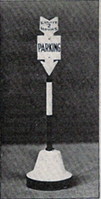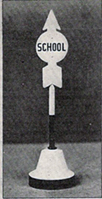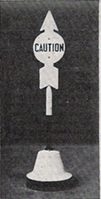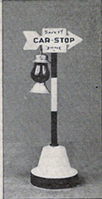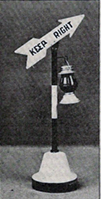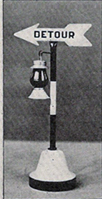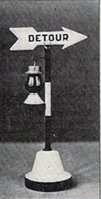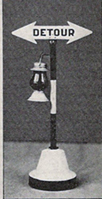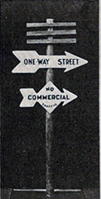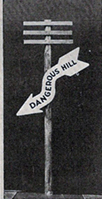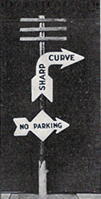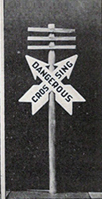The photographs here reproduced are from a set of models of traffic regulation and
direction signs prepared by the Police Department of the city of New York and displayed
at the International Police Conference, May 12-16. The adoption of arrow-shaped
signs as a uniform method of road marking was recommended by the Traffic Committee
of the Conference; the lettering to be black on a white background, and no more
words to be used than absolutely necessary.

In an address which preceded the presentation of the report, the committee's chairman,
William A. Coleman, Deputy Chief Inspector of Police of New York City, stated that
at the 1923 session of the International Police Conference recommendations had been
adopted permitting the use of an arrow on a rectangular or other shaped board, but
that in his opinion the best results would be obtained by the use of signs cut to
the arrow shape; and he added:.

"I have found from personal observation that disc or other shaped signs with an
arrow painted thereon, or on which instructions are printed, are practically useless
; they cannot be read at a distance and are absolutely useless at night, whereas
the outline of the arrow stands out, is quickly recognized and there is no mistaking
its meaning.

"Within the next few weeks all disc signs will be removed from the streets of New
York City and replaced with the arrow-shaped sign, which is best adapted for directional
purposes. For instance, placed on electric light poles in one-way streets, it cannot
have any other meaning than that traffic should move in the direction of the arrow,
and no further instructions are necessary.

"At detours, pointed right or left, it plainly indicates which way to turn.

"An arrow with a diamond-shaped plate means two things—that commercial traffic and
heavy trucks are prohibited from using that thoroughfare.

"An arrow pointed downward means "Stop."

"An arrow with a circular disc, pointed upward, placed in the vicinity of schools,
churches, courts, hospitals, and in congested streets, means "Caution; drive slowly."

"Then we have the danger signs for railroad crossings, dangerous crossing, dangerous
hills, sharp curve to right or left.

"At present we are continuing to print brief instructions on the arrows, but it
is believed that after a short time even this will be unnecessary.

"The type of sign used should be reduced to the smallest possible number, so that
their meaning may be more easily understood and remembered. While there were twelve
different types of arrow signs adopted at the Conference, there are really only
two or three of the number of arrows mentioned that will be in daily use in this
city with which it will be necessary for the public to familiarize themselves. The
one-way street sign is so well known that there is no need of explanation, and so
with the "Keep left" and "right" sign. The other signs may he unfamiliar for a while,
but they will be quickly understood.

"The use of the arrow sign should become universal, so that no matter in what part
of the world a motorist may travel, the directional sign will have the same meaning
to him. This would eliminate a lot of unnecessary confusion now encountered when
traveling from one state to another, or from one country to another. It will be
a great factor in reducing accidents and insuring safety for pedestrians.
 Colors for Traffic Light Control Systems
Colors for Traffic Light Control Systems

"This also applies to the use of lights in the control of traffic. Since the traffic
light control system was adopted in New York City we have used the following lights
in the control of traffic:

-
 Yellow light — north- and south-bound traffic moves.
Yellow light — north- and south-bound traffic moves.
-
 Red light — moving traffic stops.
Red light — moving traffic stops.
-
 Green light — east and west bound traffic moves.
Green light — east and west bound traffic moves.

"The use of these lights caused some confusion and was the subject of much criticism.
This matter was the subject of much study on the part of those concerned, and it
was finally decided to adopt a new system of light control, that is, red for "Stop,"
and green for "Go." This system was put into effect on April 27, I925, and has met
with universal approval. I recommend that this system be adopted as the standard
traffic light control system throughout the United States and other countries where
a traffic light control system is now in operation or about to be installed,"

There is nothing to be accomplished by such lines. At present such places are rare
because of the absurdly high limits we have set to the height of buildings.

One point should be kept in mind-the difference between building lines established
in a business district, for widening now or at some future time, and lines established
in residence districts for health, safety and general welfare. The former














 Yellow light — north- and south-bound traffic moves.
Yellow light — north- and south-bound traffic moves. Red light — moving traffic stops.
Red light — moving traffic stops. Green light — east and west bound traffic moves.
Green light — east and west bound traffic moves.


